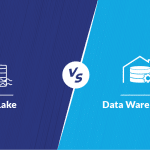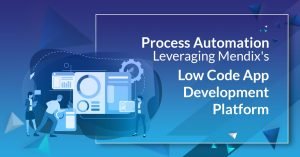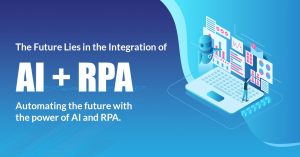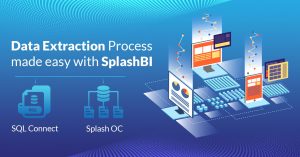Simulating human presence in getting work done to automate business processes, or Robotic Process Automation (RPA), as it is referred to in the technological domain, has been around for over two decades now. The industry is soaring high with intriguing innovations and has been ever-expanding with its potential to achieve two of the most important things any business aims to do: reduce cost and increase efficacy.
As a business grows, the amount of work and its complexity increase. This is something that RPA execution enables businesses to manage, by automating processes to be completed with greater efficiency and quality. It’s speculated that Robotic Process Automation solutions can deliver immediate savings of 25% to 40% in labour costs alone. McKinsey Digital reported that automating business processes can yield an ROI of 30 to 200 percent in just the first year.
All about Robotic Process Automation (RPA)
Robotic process automation is a software technology that eases building, deploying, and managing bots that emulate human actions in performing pre-programmed tasks. These automated presets streamline mundane, repetitive workflows, and rule-based processes, eliminating human error and increasing productivity and efficiency significantly.
Serverless RPA robots can promptly deal with any amount of data and perform tasks adhering to the rules that are specified to them with utmost accuracy, much like a call center customer support executive with a cue card specifying a response to every possible query that they will chance upon.
Serverless RPA robots are effortlessly scalable and can serve a multitude of customers within a short span of time, making it humanly impossible for FTE resources to match them. This ensures lesser waiting periods and enhances the overall customer experience as a result.
The role of AI & ML
Robotic Process Automation is often confused with Artificial Intelligence and Machine Learning. Artificial intelligence leverages computers and machines to emulate the problem-solving and decision-making faculties of the human mind. While it is capable of dealing with structured data alone, AI comes in handy to structure semi-structured and unstructured data. In other words, RPA can only act upon pre-programmed rules, but AI, with the power of ML, can teach itself and accommodate the scope for constant experience-based improvement.
In unison, Robotic Process Automation & AI can be unstoppably productive as they complement each other by effectively filling quintessential gaps, as the former is required to deal with the volume of work and the latter with breaking down the increasing complexity of tasks, opening doors to endless possibilities.
AI-driven Robotic Process Automation (RPA) to increase business ROI:
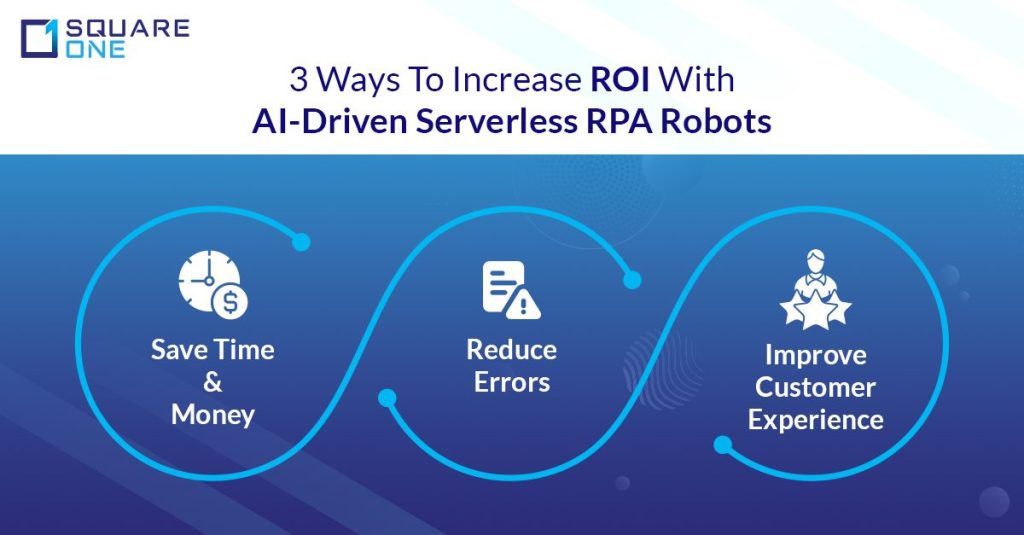
Here are 3 reasons to choose AI-driven Robotic Process Automation for your business to increase efficiency & achieve a higher return on investment:
- Save time and money
Fully functioning RPAs that are backed by Artificial Intelligence can save a significant amount of money invested in resources by replacing Full-Time Equivalents (FTEs). In addition, their unmatched productivity and efficacy are bound to accelerate the time taken to close tasks and optimize the output quality. Many components of robotic automation can be repurposed on subsequent projects, further plummeting the cost of development.
- Reduce errors
Robotic Process Automation tools play by their rules with data structured by AI thereby leaving no room for error alongside the ability to learn from mistakes and consistently optimize their knowledge/ rules based on experience. Automating RPA substantially increases the accuracy of tasks thereby diminishing the expenditure of time and resources.
- Improve customer experience
Automated functions allow businesses to interface and serve customers in real time while collecting and presenting data, facilitating a quicker service and improved experience. AI-backed Robotic Process Automation tools are capable of hyper-personalizing interactions with customers through data that are captured and stored, reducing the risk of error.
In today’s challenging economic climate, the demand for heightened productivity and operational efficiency is at an all-time high for businesses of all sizes. However, the full potential of Robotic Process Automation (RPA) has yet to be realized due to several factors, including the persistent stigma surrounding automated processes and the time required for successful implementation.
Nevertheless, automation, including RPA, is on the rise across diverse sectors such as Marketing, Banking, Finance, and Technology. Businesses are beginning to grasp the benefits of RPA, which can free up human resources from routine tasks, enabling them to focus on more strategic endeavors. This shift is driven by the potential for significant cost savings and increased efficiency.
According to Gartner, around 85% of large and international organizations are expected to invest in some form of RPA, signalling a growing recognition of its transformative potential. As businesses adapt to evolving economic challenges, RPA is poised to play an increasingly vital role in enhancing productivity and operational efficiency.


